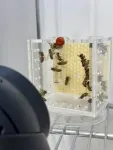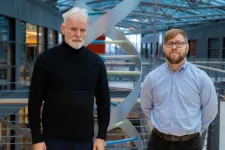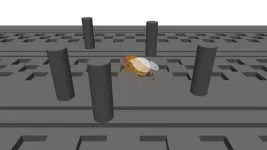(Press-News.org) University of B.C. researchers have developed a groundbreaking coating that could make medical devices safer for millions of patients, reducing the risks associated with blood clots and dangerous bleeding.
The new material, designed to mimic the natural behavior of blood vessels, could allow for safer use of blood-contacting devices like catheters, stents, blood-oxygenation machines and dialysis machines—especially in cases where blood clots are a significant concern.
“This discovery could be a transformative step in the development of safer medical devices,” said Dr. Jayachandran Kizhakkedathu, a professor of pathology and laboratory medicine and Tier 1 Canada Research Chair in Immunomodulation Materials and Immunotherapy who led the study out of the Center for Blood Research at UBC. “By designing a coating that mimics the body’s natural approach to preventing clots, we’ve created a solution that could dramatically reduce the need for risky blood thinners before and after patients use these devices.”
Thrombosis, or clot formation, is a major challenge when blood-contacting devices are used. Unlike natural blood vessels, these devices can trigger clotting by activating specific proteins in the blood. Blood clots can obstruct the device, disrupting treatment, or lead to severe complications such as stroke and heart attack.
Doctors often prescribe high doses of blood thinners to prevent clots on these devices, but this approach increases the risk of dangerous bleeding—a trade-off that many patients and clinicians would rather avoid.
The newly developed coating offers a promising alternative. It’s engineered to imitate how blood vessels function—encouraging normal blood flow without triggering clot formation. Imagine the coating as a “soft barrier” on a device that attracts a key blood protein but keeps it from activating the clotting process.
“By interacting with this protein in a controlled way, the coating prevents it from sparking a cascade of events that lead to clot formation,” said Dr. Haifeng Ji, a Michael Smith Health Research BC postdoctoral fellow at the Center for Blood Research and first author of the study.
In lab and animal studies, the coating demonstrated significant reductions in clot formation on device surfaces, without the use of blood thinners and without affecting the normal clotting functions elsewhere in the body.
“One of the most surprising insights was that controlling the interaction between the coating and specific blood proteins could prevent clotting without disrupting the body’s natural balance,” Dr. Kizhakkedathu said. “This shows us that mimicking the body’s own mechanisms, rather than simply repelling blood components, is key to truly biocompatible device design.”
The innovation comes as demand for blood-contacting devices continues to rise. In the U.S. alone, millions of vascular catheters are placed each year, and hundreds of thousands of patients depend on devices like dialysis machines to maintain their health.
Looking ahead, the research team plans to explore how this innovative coating could be further optimized and applied to a broader range of blood-contacting devices. Key questions remain about how the coating interacts with other blood proteins and cells, and whether the coating interacts with coagulation proteins through single-layer or multi-layer designs.
Additionally, the team is interested in understanding whether this approach could eventually be adapted to address other blood-related complications, such as inflammation or infection, in long-term medical implants.
By delving deeper into the biological mechanisms that make this coating so effective, future studies could pave the way for a new generation of medical devices that not only prevent clotting but integrate seamlessly with the body’s natural processes.
END
Blood vessel-like coating could make medical devices safer for patients
2024-11-12
ELSE PRESS RELEASES FROM THIS DATE:
Sleep is no light matter for bees
2024-11-12
In an emerging red flag for the digital era, sleep experts have warned us to avoid screen time in bed, sounding the alarm that light emitted from phones and other electronic devices can disrupt our sleep patterns. That’s one way that science is waking up to the broad range of health and disease implications related to circadian biology and our daily sleep-wake cycles.
Now, researchers at the University of California San Diego have found that light disruption is not only a health concern for humans. A new study led by PhD candidate Ashley Kim and Professor James Nieh in the School of Biological Sciences has found that artificial light disrupts the circadian rhythms of ...
New study explores the role of BMI in disease risk
2024-11-12
New study from deCODE genetics/Amgen highlights the importance of BMI in pathogenesis of disease, suggesting that reducing BMI alone could lower the risk of several diseases.
Scientists at deCODE genetics, subsidiary of Amgen, published a study today in Nature Communications that sheds light on how Body Mass Index (BMI) influences the risk of various diseases that are comorbid with obesity. The study, which used genetic data from Iceland and the UK Biobank, looked at whether disease risk associated with BMI-related sequence variants are explained completely or partially by their effect on BMI.
The results showed that for some conditions, such as fatty liver disease, glucose intolerance, ...
Guardian, kids, or companions? What do dogs mean to us today
2024-11-12
What role do dogs play in today’s world? For many, they are more than just pets. New findings from the Department of Ethology at Eötvös Loránd University show that whether seen as friends, family members, children or guardians, these roles affect the way dogs are cared for, suggesting shifting dynamics in human-animal bonds shaped by societal trends and individual owner profiles.
In Western cultures, more and more people see their dogs as their best friends, family members or even their furry children. In fact, ...
NeuroMechFly v2: Simulating how fruit flies see, smell, and navigate
2024-11-12
All animals, large or small, have to move at an incredible precision to interact with the world. Understanding how the brain controls movement is a fundamental question in neuroscience. For larger animals, this is challenging because of the complexity of their brains and nervous systems. But the fruit fly, Drosophila melanogaster, has a smaller and therefore more easily mappable brain, allowing scientists to gain detailed insights into how its nervous system drives behavior.
To understand how the nervous system controls actions, researchers at the group of Pavan Ramdya at EPFL created a simulated reality where a virtual fly can operate ...
“Drowning” mangrove forests in Maldives signal global coastal threat
2024-11-12
Researchers have found evidence that mangrove forests – which protect tropical and subtropical coastlines – are drowning in the Maldives.
Their findings, published today (Tuesday 12 December) in Scientific Reports, indicate that rising sea level and a climate phenomenon known as the Indian Ocean Dipole have led to some Maldivian islands losing over half of their mangrove cover since 2020.
The research team, led by Northumbria University, warn that the findings have implications not only for the Maldives, but also for other island nations and coastal ecosystems around the world.
In 2020, more than a quarter of the Maldivian islands containing mangrove forests saw their trees experiencing ...
When muscles work out, they help neurons to grow, a new study shows
2024-11-12
There’s no doubt that exercise does a body good. Regular activity not only strengthens muscles but can bolster our bones, blood vessels, and immune system.
Now, MIT engineers have found that exercise can also have benefits at the level of individual neurons. They observed that when muscles contract during exercise, they release a soup of biochemical signals called myokines. In the presence of these muscle-generated signals, neurons grew four times farther compared to neurons that were not exposed to myokines. These cellular-level experiments suggest that exercise can have a significant biochemical effect on nerve growth.
Surprisingly, the researchers also ...
Smokers who switch to vaping see improved respiratory health
2024-11-12
A new paper in Nicotine and Tobacco Research, published by Oxford University Press, finds that people who switch from smoking cigarettes to vaping see improved respiratory health, but people who begin consuming electronic cigarettes while continuing to smoke regular cigarettes do not report improved respiratory symptoms.
Adults increasingly use electronic cigarettes to try to quit smoking because of the perceived reduced risk. But while vaping reduces exposure to toxic chemicals, it has been unclear whether switching from cigarettes to e-cigarettes results in a reduction of the respiratory problems—like wheezing and coughing—common in regular cigarette ...
Air pollution emerges as critical environmental risk factor for autism, emerging topic review finds
2024-11-12
Boston, Massachusetts, 12 November 2024 – Environmental exposure to air pollutants during critical developmental periods may significantly impact autism risk, according to a groundbreaking Emerging Topic review published 12 November 2024, in Brain Medicine. The study reveals how common air pollutants, including fine particulate matter and nitrogen oxides, can trigger complex biological cascades affecting brain development.
"Different kinds of neurological disorders, including autism spectrum disorder, can be associated ...
Autism and nitric oxide: Professor Haitham Amal unveils brain disorder breakthrough
2024-11-12
Boston, Massachusetts, 12 November 2024 – The complex interplay between nitric oxide and brain disorders takes center stage in the latest Genomic Press Interview, published November 12, 2024, in Brain Medicine. Professor Haitham Amal, head of the Laboratory of Neuromics, Cell Signaling, and Translational Medicine at the Hebrew University of Jerusalem, shares insights into his groundbreaking research and personal motivation.
“Meeting families and children with autism in Boston during my time at MIT inspired me to focus on a single goal: to help develop biological diagnostics ...
Facing the wind: How trees behave across various forest settings and weather events
2024-11-12
Destructive winds during storms and cyclones often cause tree failures, especially through uprooting and stem breakage. However, how trees respond to wind under various forest configurations and weather conditions remains unclear. A recent study on Cryptomeria japonica plots shows that trees dissipate wind energy by switching between two swaying behaviors at specific wind speeds, offering insights that may help in improved forest management to minimize damage caused by storms.
Extreme weather events, such as tropical and extratropical cyclones and tornadoes, can cause widespread damage to forests, leading to environmental and financial ...











